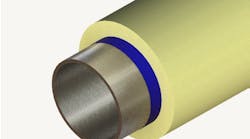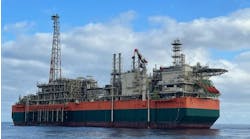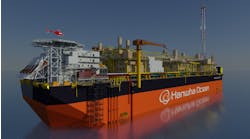Gulf of Mexico: Will royalty relief, gas prices bail out US Gulf shelf production in rapid decline?
Without efforts to drill for deep gas and oil reserves, US Gulf shelf production will continue on a rapid decline.
Oil and gas production from the Gulf of Mexico continental shelf is in decline, posing a challenge for the US Minerals Management Service (MMS), which regulates activity there. The decline also poses a problem for producers and pipeline owners, who have an investment in infra-structure and supply contracts.
In contrast, oil and producers are projected to earn $34.4 billion in wellhead revenue from US Gulf leases, net of royalty, for 2001, more than double the $15.2 billion earned in 1999. If realized, this will be a record in wellhead revenue produced net of royalty for the US Gulf.
To counter falling shelf gas production (although not the case in deepwater), the MMS has proposed royalty relief as an incentive for drilling deep gas deposits in the shallow water shelf area of the Gulf of Mexico by providing for royalty suspension for the first 20 Bcf of production from a well drilled 15,000 ft below sea level.
Shelf royalty relief for deep gas drilling, and more significantly, the number of leases expiring in 2001, will drive up drilling in the Gulf of Mexico in 2001. A total of 1,153 wells are projected to be drilled in 2001. This number would be up 16% from the total wells drilled in 2000, and up almost 42% from the number drilled in 1999 (see accompanying graph). The increase over 1999 figures is largely a result of the escalation of deepwater drilling, while the increase over 2000 figures will be partially attributable to interest in gas drilling.
Shelf in decline
Annual oil production on the shelf and in less than 1,000 ft water depths in the US Gulf of Mexico has never recovered from the 375 million bbl level produced in 1971-1972. A brief recovery occurred in the 1984-1986 period (about 325 million bbl each year), and again in 1996-1997, but oil production trended downward over the 30-year period. Shelf production in 1999 was about 250 million bbl, down from 285 million bbl produced in 1997.
Annual gas production on the shelf and in less than 1,000 ft water depths peaked in 1981 at 4.75 Tcf. After that gas volumes fell off, but cycled between 4.6 Tcf and 3.8 Tcf in the following years. By 1999, sub-1,000 ft gas production was at 3.8 Tcf.
Both oil and gas production are in decline, especially on the shelf, where workover operations have managed to extend some fields. Generally, production off the shelf has keep gas production alive and pipelines filled.
But, that period may be coming to an end, unless deep drilling at the edge of the continental shelf, under and around salt bodies, turns up a great deal more oil and gas than producers expect. The MMS hopes to keep gas production from falling off precipitously, by providing royalty relief for those deep gas wells (>15,000 ft depth) to be drilled on shelf leases acquired in OCS Sale No. 178 on March 28, 2001. Fortunately, the Gulf of Mexico remains prospective at great depths.
Deepwater oil production
By contrast, oil production, and to a lesser degree gas, in water depths beyond the 1,000 ft contour continues to escalate rapidly. Interest-ingly, in the 1983-1984 period, deepwater prod-uction began to rise, as a result of those fields producing on the slope just beyond the continental shelf.
Oil output slowed during the following years with the low price of oil. The cost of deepwater technology was high and oil prices in the late 1980s simply did not provide the support to undertake the risks.
During the early 1990s, however, technology began to meet some of the hurdle rates required, and deepwater became more prospective. As a result, deepwater oil production rose from 20 million bbl annually in 1990 to nearly 48 million bbl in 1994.
During the following three years, oil production rose slowly, and then began to climb rapidly, as truly large reserves came onstream. Production rose from 80 million bbl annually in 1997 and reached 220 million bbl in 1999.
Deepwater gas production
Following a low stable point in the 1986-1990 period, gas production also began to escalate rapidly in deepwater (>1,000 ft). Annual production rose from a figure of 45 bcf in 1990 and grew by nearly 80% per year until 1996.
Most of the gas produced was associated gas from wells on the slope, very close to the continental shelf where gas pipelines were available.
After a period of little change, gas production shot up 125% or more during the 1997-1999 period, as a result of very large contributions from several gas only fields brought into production at that time.
Total wells projected
The total wells projected to be drilled in 2001 will be fewer that the record 1,217 wells drilled in 1997, and just below 1,160 wells drilled in 1996. The 1996-1997 period experienced rising crude oil prices and strengthening gas prices, which drove up the drilling rate.
Deepwater drilling will be fairly constant in 2001, since rig utilization for units with deepwater capability, is right at 100%. Several more rigs will be launched in 2001, adding slightly to well capability, but the long break-in time required for these giant units may not contribute significantly to drilling in 2001.
Deep drilling risk
Gas reserves at true vertical well depths greater than 15,000 ft below sea level on the continental shelf are the target of MMS's royalty relief efforts. These reserves were initially overlooked by seismic imaging technology of 1970s and 1980s, or were left behind by producers searching for easily recovered oil and gas.
In addition, salt bodies complicated much of the drilling in the greater depths along the edge of the continental shelf. Wells drilled today beyond 15,000 ft total depth are likely to traverse near or have to go through salt bodies. In addition to much improved 3D seismic inaging today, drillers will benefit from technology critical to controlling bit direction and wellbore positioning. This technology caps the cost risk involved in drilling around salt. However, wells drilled to and beyond 15,000 ft total depth are likely to be fairly costly, although not as much as deepwater wells. Producers undertaking deep gas drilling (>15,000 ft) would receive royalty relief of $0.75/Mcf on gas priced at $5.00/Mcf, which calculated on 20 Bcf produced free of royalty would amount to $15 million. If unfettered by any time constraints, this would provide a huge incentive for deep gas discoveries.
Producers and pipelines
For the producers, US natural gas prices in the $5-8/Mcf range are a strong incentive, particularly independents, who do the majority of gas drilling on the shelf. The problem with shelf gas drilling today is the rather small accumulations of reserves found and the resulting short production life span. The 1-3 year gas production life forces producers to maintain a very active program of tract acquisition, farming in, rig leasing, and platform re-use, in order to maintain pipeline injection quotas and cash flow.
At the same time, gas producers have to watch development costs for gas production carefully. If US gas prices plunge in the coming 6-12 months, producers could be stuck with producing high cost gas in a weakening gas price market.
Falling shelf production is critical for gas pipeline owners also, who must keep lines filled in order to meet contractual volume requirements. Gas from deepwater developments took regulators attention away from the growing shortfall in early and mid-2000, but the advent of a normal 2000-2001 winter and low storage volumes in the US have re-instated concerns that rolling curtailments will be necessary on distribution levels.
Price projections
A bbl oil equivalent (BOE) in 2001 is projected to average $28.26 for the entire year, somewhat higher than the $24.68/BOE in 2000, and dramatically higher than the $14.33-14.36/BOE recorded in the 1998-1999 period (see accompanying table on wells drilled).
The $28.26/BOE average projected for 2001 breaks down into $30/bbl of WTI crude oil estimated on average for the year and $4.50/Mcf estimated on average for 2001 natural gas.
Not only will high oil and gas prices contribute to the projected $34.4 billion wellhead income net of royalty earned by producers in the US Gulf in 2001, but relatively low drilling and logging costs will contribute to that elevated income.
For example, drilling and logging costs are projected (see accompanying table) to be about 16% of estimated leasehold income net of royalty. This is only 1% higher than the cost share of wellhead income in 2000 (15%). Interestingly, in 1999, producers had to shoulder much higher costs relative to leasehold wellhead income (27%). The year 1999 was the last of a five-year interval when costs remained a relatively high proportion of wellhead income net of royalty (see table).
Total production
Oil production in the US Gulf was projected to hit 500 million bbl in the year 2000, an average of 1.37 million b/d. This production level has been a steady climb from a low point of 263 million bbl produced in 1979, and over 8% higher than the rate achieved in 1999. Oil production is expected to reach 600 million bbl in the year 2001.
US Gulf crude oil reserves for 1998, the last year for which data is available, was estimated to reach 5 billion bbl. Reserves volumes would probably total 5-6 billion bbl by early 2001, as a result of the growing number of deepwater discoveries.
Natural gas production for the year 2000 in the US Gulf is projected to hit 5 Tcf, also a modern record. Since 1978, gas production has exceeded 4 Tcf and climbed very close to 5 Tcf in 1981 and again in the 1996-1998 period.
Natural gas reserves dropped steadily since the early 1980s and was estimated at 33 Tcf in 1998, the last year in which figures are available. That number is slightly higher than in previous years, but the lack of normal winter conditions has prevented a substantial drawdown on reserves. Gas reserves topped 45.8 in 1986, the highest point in gas reserves for the US Gulf.
Leases expiring
Through October of 2000, a total of 777 wells were drilled on leases in federal and state waters (705 on federal and 72 on state). This number was used to project a total of 994 wells for all of 2000.
Seldom has the number of wells exceeded 1,000 in the 1990s. The years 1990, 1996, and 1997 are exceptions. The number of wells projected for 2001, 1,153, will surpass the total through all of the last decade, if realized.
A major reason for the 1,153 wells projected to be drilled in 2001 is the number of leases that could conceiveably expire undrilled in 2001. A total of 724 leases, scheduled to expire in 2001, were undrilled as of November 30, 2000.
Many of the 724 leases will be drilled during the year, but the number is huge compared to the 137 leases that were undrilled as of November 30, 2000. In addition, 505 leases expiring in 2002 were undrilled as of November 30. The number of undrilled leases expiring falls off sharply after that and does not increase until 2006 and 2007.
Minimal relief
Before Sale 177 (August, 2000), there were 1,504 leases held in primary term in water depths of less than 1,000 ft that were undrilled on November 30, 2000. Of that number, 210 leases (14%) were held by major operators, and 1,294 (86%) were held by independent operators, most of which will have expired by the year 2005.
Deep gas royalty relief as proposed by MMS will apply only on those leases acquired in Sale 178 in March 28, 2001, which are in water depths of 200 meters or less, and then only to gas reserves produced at true vertical well depths drilled below 15,000 ft from sea level.








